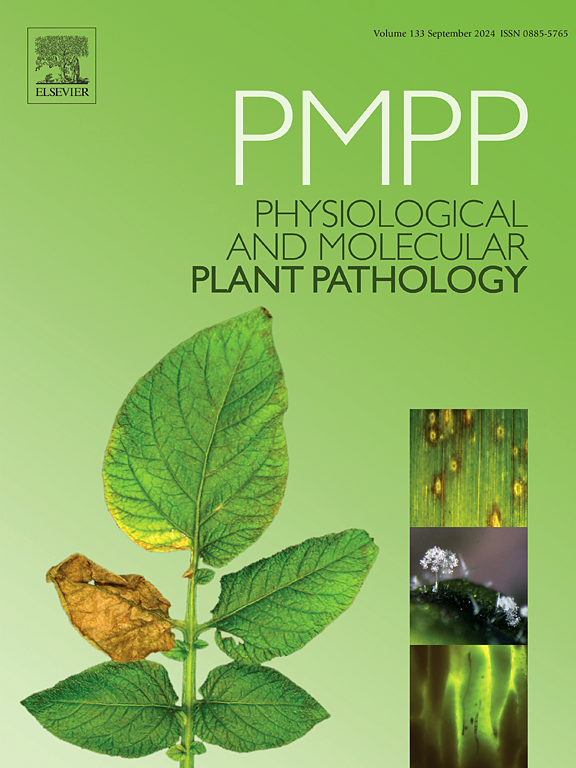Azelaic acid enhances tomato resistance to Alternaria solani via defense responses and lignin biosynthesis
IF 2.8
3区 农林科学
Q2 PLANT SCIENCES
引用次数: 0
Abstract
Tomato (Solanum lycopersicum) yield is drastically lowered by Alternaria solani-induced early blight. This study evaluates azelaic acid as a resistance inducer against A. solani in susceptible tomatoes, with emphasis on defense mechanisms and lignin biosynthesis. Pathogenesis-related (PR) enzyme activities (e.g., PAL, LOX, chitinase, laccase, β-1,3-glucanase), phenolic and flavonoid compounds, and lignin deposition were measured after azelaic acid treatment and pathogen infection under controlled greenhouse conditions. qRT-PCR was used to determine gene expression of defense-related transcription factors (SINAC1, SIWRKY1, SIMAPK3, TPK1b) and defense genes for lignin biosynthesis, and lignin deposition was assessed by histology and spectrophotometry. Azelaic acid significantly suppressed disease severity, with LOX, chitinase, and laccase activities restored during infection, and PAL and laccase activities optimized at 24–48 h post-inoculation (hpi). PPO activity was 11.19 U/mg protein.min−1 in inoculated plants at 96 hpi. Phenolic and flavonoid contents were high at 12 hpi in treated plants, whereas lignin deposition and gene expression (e.g., PAL) were highest in inoculated plants, further enhanced by azelaic acid-induced lignification. Increased lignin deposition, strengthening physical defenses, was also confirmed by histological analysis. These results affirm that tomato resistance against A. solani is induced by azelaic acid through the induction of PR enzymes, regulation of lignin biosynthesis, and defense gene expression. This multi-faceted approach highlights the potential of azelaic acid as an eco-friendly method of managing early blight disease.
杜鹃花酸通过防御反应和木质素生物合成增强番茄对茄赤霉的抗性
番茄早疫病对番茄产量的影响很大。本研究评价了壬二酸对番茄番茄枯萎病的抗性诱导作用,重点研究了其防御机制和木质素的生物合成。在控制的温室条件下,测定了壬二酸处理和病原菌侵染后的致病性相关酶(PR)活性(如PAL、LOX、几丁质酶、漆酶、β-1,3-葡聚糖酶)、酚类化合物和类黄酮化合物以及木质素沉积。采用qRT-PCR检测防御相关转录因子(SINAC1、SIWRKY1、SIMAPK3、TPK1b)和木质素生物合成防御基因的基因表达,采用组织学和分光光度法评估木质素沉积。壬二酸显著抑制了疾病严重程度,感染后LOX、几丁质酶和漆酶活性恢复,PAL和漆酶活性在接种后24-48 h (hpi)达到最佳。PPO活性为11.19 U/mg蛋白。接种植株在96 hpi时Min - 1。在12 hpi时,处理植株的酚类和类黄酮含量较高,而木质素沉积和基因表达(如PAL)在接种植株中最高,并在壬二酸诱导的木质素化作用下进一步增强。增加木质素沉积,增强物理防御,也证实了组织学分析。这些结果证实,杜鹃花酸通过诱导PR酶、调控木质素的生物合成和防御基因的表达,诱导番茄对茄蚜的抗性。这种多方面的方法突出了壬二酸作为一种管理早期枯萎病的环保方法的潜力。
本文章由计算机程序翻译,如有差异,请以英文原文为准。
求助全文
约1分钟内获得全文
求助全文
来源期刊
CiteScore
4.30
自引率
7.40%
发文量
130
审稿时长
38 days
期刊介绍:
Physiological and Molecular Plant Pathology provides an International forum for original research papers, reviews, and commentaries on all aspects of the molecular biology, biochemistry, physiology, histology and cytology, genetics and evolution of plant-microbe interactions.
Papers on all kinds of infective pathogen, including viruses, prokaryotes, fungi, and nematodes, as well as mutualistic organisms such as Rhizobium and mycorrhyzal fungi, are acceptable as long as they have a bearing on the interaction between pathogen and plant.

 求助内容:
求助内容: 应助结果提醒方式:
应助结果提醒方式:


